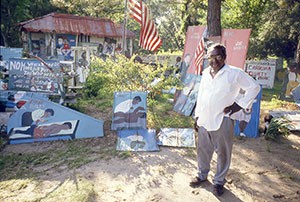Born 1906, near Frogmore, South Carolina
Died 1985, Beaufort, South Carolina
Sam Doyle grew up on Saint Helena Island, a remote South Carolina enclave populated mainly by the descendants of African slaves, who vastly outnumbered whites. Due to its isolation and its ethnic concentration, Gullah culture took root here, giving the island a distinct tradition with African roots that persisted with rare continuity into Doyle’s time. Doyle attended Penn School, the first such institution that Philadelphia Quakers established in the South. Despite his artistic talent being noticed, he dropped out of school in ninth grade to find work. After retiring and dedicating himself to painting in the 1970s, he came to national attention with the Black Folk Art in America, 1930–1980 exhibition in 1982.
Doyle initially displayed his paintings, realized mostly in enamel house paint on roofing tin, in the yard outside his home, surrounded by inventive animal sculptures. Fellow islanders were his primary audience and his chief subjects. He depicted their accomplishments, paying homage to the first black doctor, policeman, or embalmer, as well as people’s personal, often sexual, idiosyncrasies. His paintings essentially served as a community clearinghouse, whether in the form of gossip or documentary. They were also a conduit for the lore of the island and the spiritual beliefs and superstitions of its inhabitants.
The apparent simplicity of Doyle’s compositions belies the intricacy of their conception and allusions. Scraped and swirled planes of color weave body language together with hand-painted phrases to create surfaces dense with meaning. Paintings of two women kissing and the island’s first black midwife celebrate local subjects and betray a hint of judgment. Doyle also painted African American heroes such as the world heavyweight champion Joe Louis, known as the “Brown Bomber.” LiNCOLN iN FROGMORE depicts a local legend, which maintained that the sixteenth president rallied the slave population of the island early in the Civil War. In addition to expressive depictions of his contemporaries and historical figures from the African American pantheon, the devout Doyle painted religious subjects. In his final years his work was increasingly in demand among contemporary artists and art aficionados.
Jenevive Nykolak
Perry, Reginia. “Sam Doyle, St. Helena Island’s Native Son.” In Raw Vision: International Journal of Intuitive and Visionary Art, Outsider Art, Art Brut, Contemporary Folk Art, Self Taught Art 23 (Summer 1998): 28–35.
Spriggs, Lynne E. Local Heroes: Paintings and Sculpture by Sam Doyle. Atlanta: High Museum of Art, 2000.
